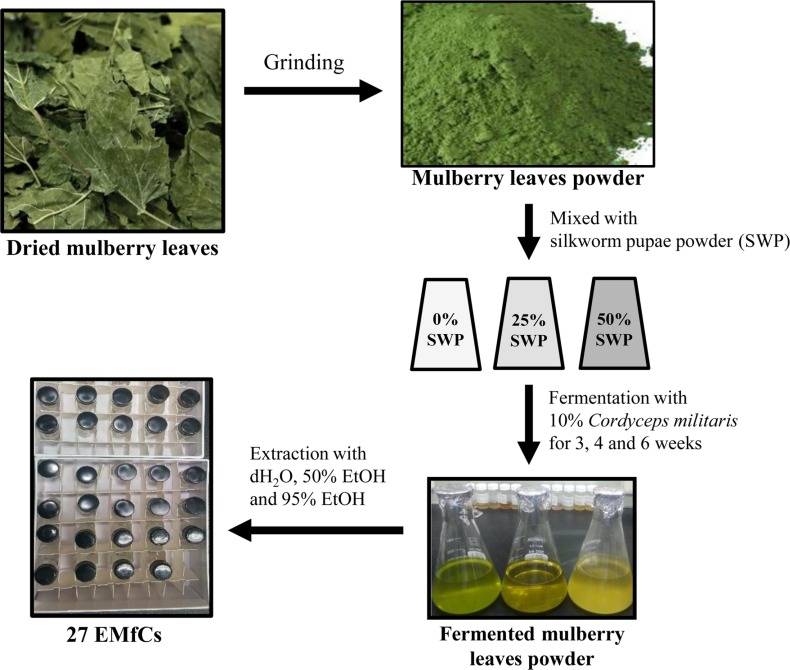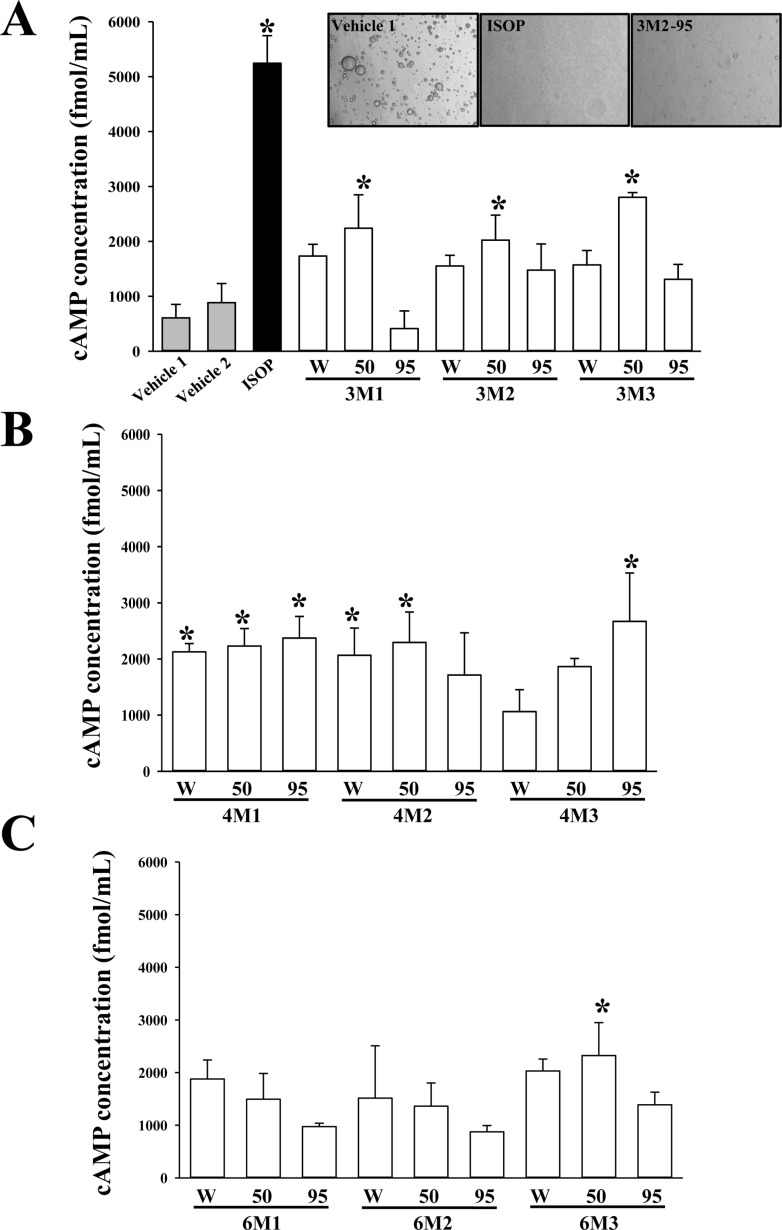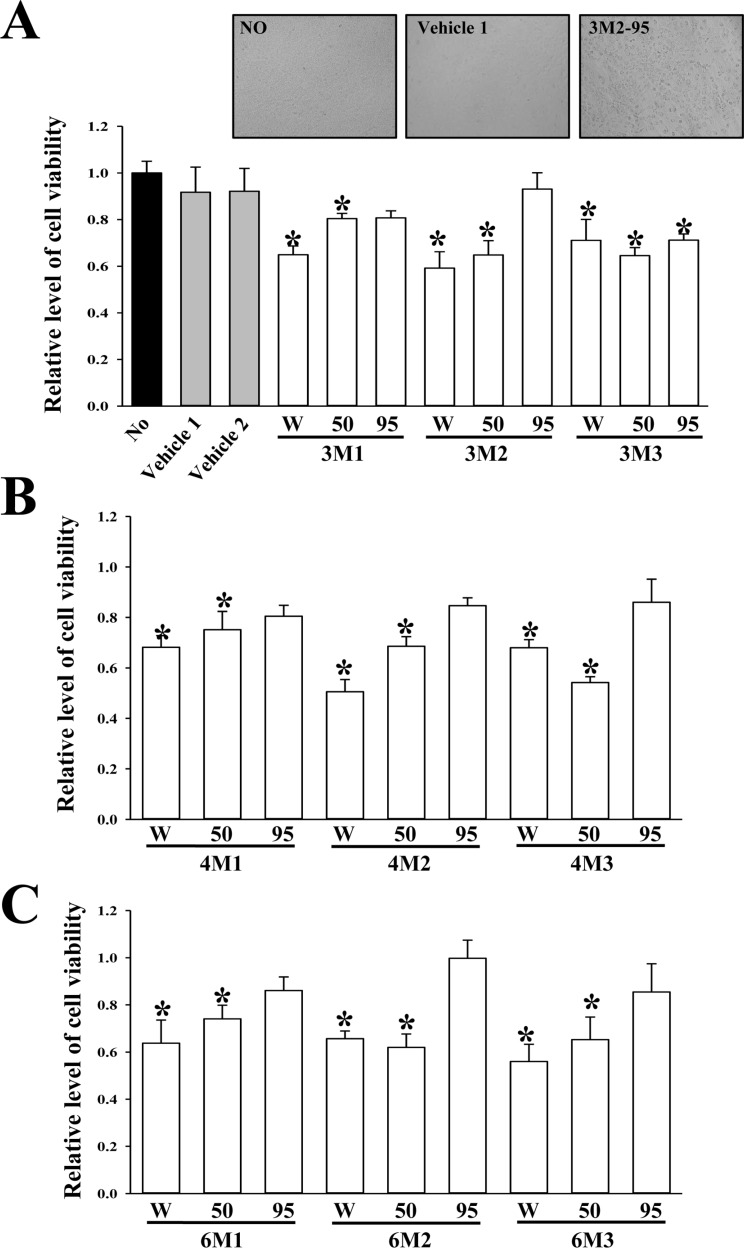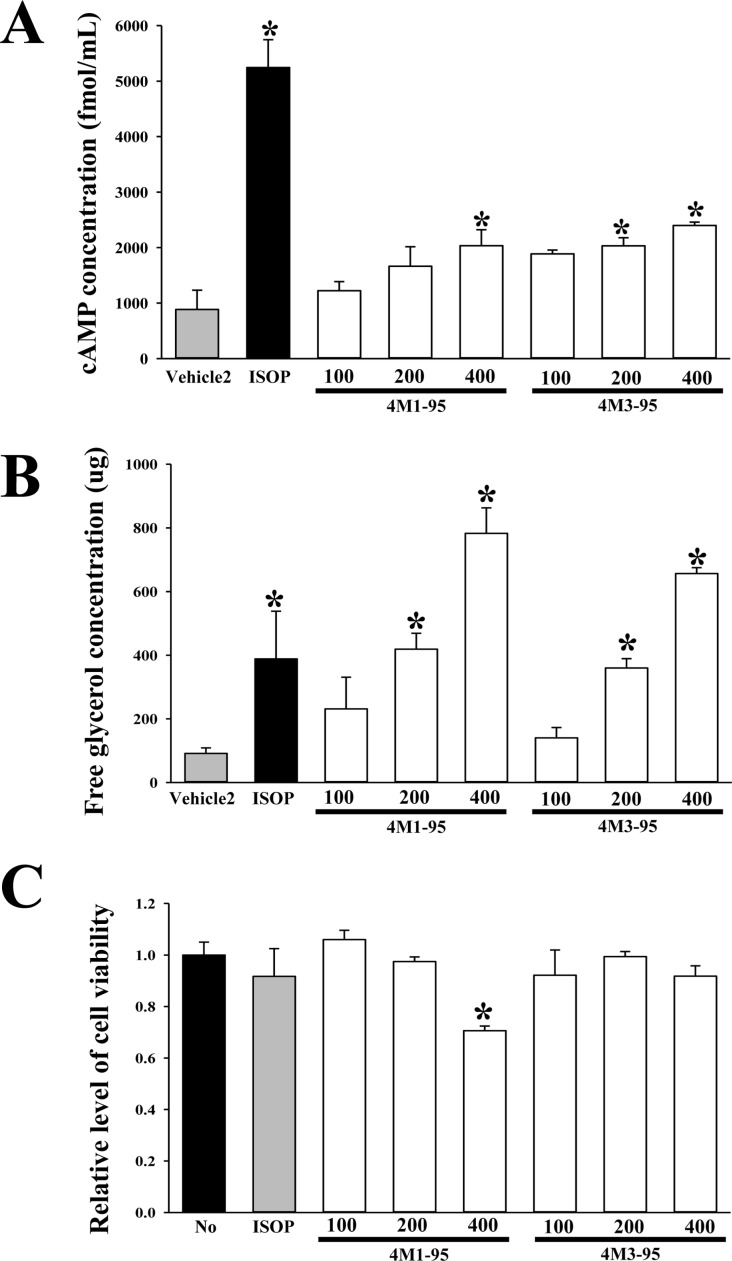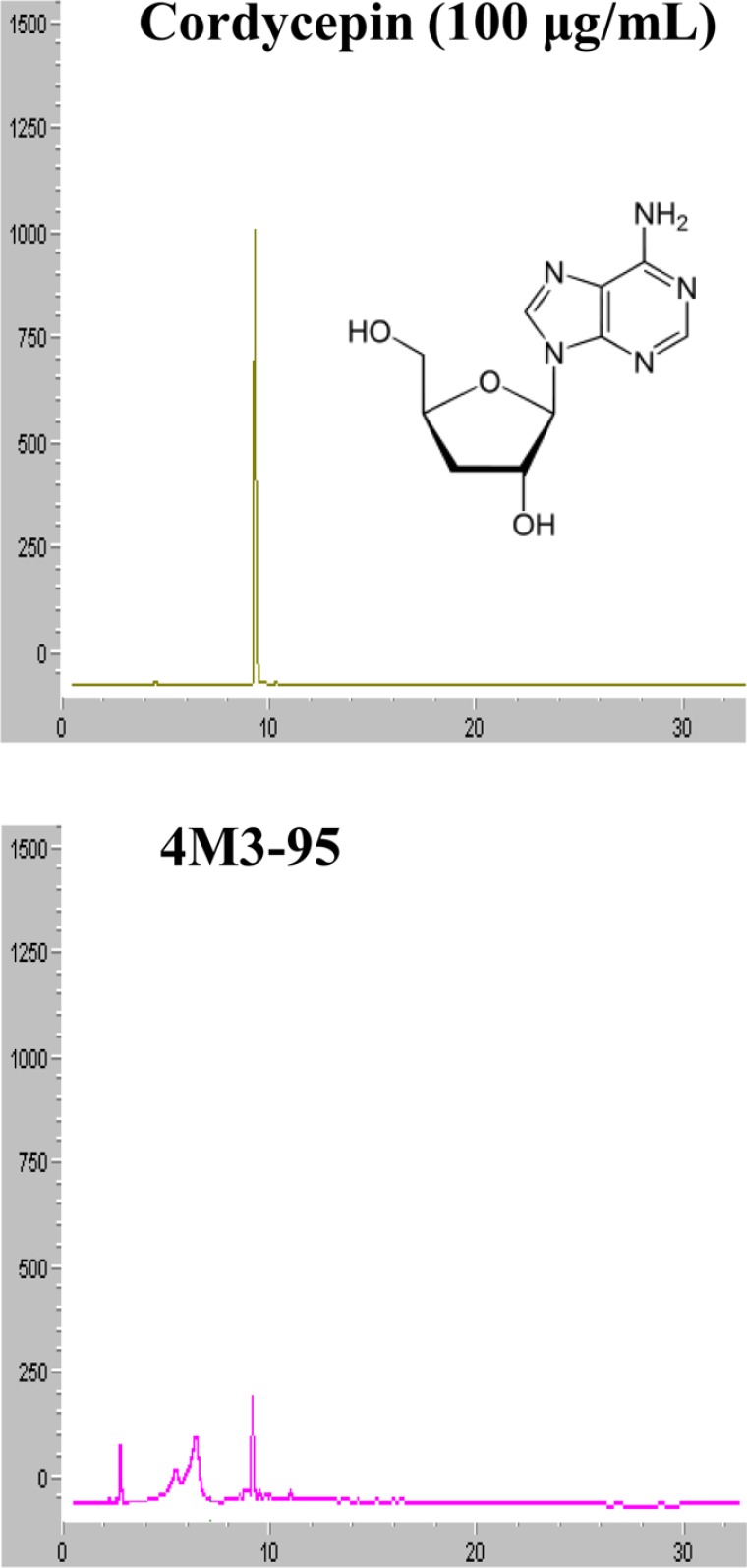Lab Anim Res.
2017 Sep;33(3):270-279. 10.5625/lar.2017.33.3.270.
Lipolytic effect of novel extracts from mulberry (Morus alba) leaves fermented with Cordyceps militaris in the primary adipocytes derived from SD rats
- Affiliations
-
- 1Department of Biomaterials Science, College of Natural Resources & Life Science/Life and Industry Convergence Research Institute, Pusan National University, Miryang 50463, Korea. dyhwang@pusan.ac.kr
- 2Department of Horticultural Bioscience, College of Natural Resources & Life Science/Life and Industry Convergence Research Institue, Pusan National University, Miryang 50463, Korea.
- 3Life Science Research Institute, Novarex Co., Ltd., Chungju 28126, Korea.
- KMID: 2391102
- DOI: http://doi.org/10.5625/lar.2017.33.3.270
Abstract
- Mulberry (Morus alba) leaves are known to have therapeutic effects on lipid metabolism including lipogenesis, lipolysis and hyperlipidemia. However, novel compounds with strong lipolytic ability among 27 extracts of the mulberry leaves fermented with Cordyceps militaris (EMfCs) have not yet been identified. Therefore, the cAMP concentration and cell viability were measured in the primary adipocytes of SD (Sprague Dawley) rats and 3T3-L1 cells after treatment of 27 EMfCs. Briefly, mulberry leaves powders amended with three different concentrations (0, 25 and 50%) of silkworm pupae (SWP) powder were fermented with 10% C. militaris (v/w) during three different periods (3, 4 and 6 weeks). A total of 27 extracts were obtained from the fermented mulberry leaves powders using three different solvents (dH2O, 50% EtOH and 95% EtOH). Among the 27 EMfCs treated groups, a significant increase in the concentration of cAMP was detected in primary adipocytes treated with 10 extracts when compared with the Vehicle treated group. However, their cAMP concentration did not agree completely with the non-toxicity, although most extracts showed non-toxicity. Furthermore, the concentration of cAMP and level of free glycerol gradually increased in a dose dependent manner (100, 200 and 400 µg/mL) of 4M3-95 contained cordycepin without any significant toxicity. Overall, the results of this study provide strong evidence that 4M3-95 extract derived from EMfCs can stimulate the lipolysis of primary adipocytes at an appropriate concentration and therefore have the potential for use as lipolytic agents to treat obesity.
Keyword
MeSH Terms
Figure
Reference
-
1. Ho JN, Kim OK, Nam DE, Jun W, Lee J. Pycnogenol supplementation promotes lipolysis via activation of cAMP-dependent PKA in ob/ob mice and primary-cultured adipocytes. J Nutr Sci Vitaminol (Tokyo). 2014; 60(6):429–435. PMID: 25866307.2. Lafontan M, Langin D. Lipolysis and lipid mobilization in human adipose tissue. Prog Lipid Res. 2009; 48(5):275–297. PMID: 19464318.
Article3. Langin D, Dicker A, Tavernier G, Hoffstedt J, Mairal A, Rydén M, Arner E, Sicard A, Jenkins CM, Viguerie N, van Harmelen V, Gross RW, Holm C, Arner P. Adipocyte lipases and defect of lipolysis in human obesity. Diabetes. 2005; 54(11):3190–3197. PMID: 16249444.
Article4. Carmen GY, Víctor SM. Signaling mechanisms regulating lipolysis. Cell Signal. 2006; 18(4):401–408. PMID: 16182514.5. Zimmermann R, Strauss JG, Haemmerle G, Schoiswohl G, Birner-Gruenberger R, Riederer M, Lass A, Neuberger G, Eisenhaber F, Hermetter A, Zechner R. Fat mobilization in adipose tissue is promoted by adipose triglyceride lipase. Science. 2004; 306(5700):1383–1386. PMID: 15550674.
Article6. Ho JN, Jang JY, Yoon HG, Kim Y, Kim S, Jun W, Lee J. Antiobesity effect of a standardised ethanol extract from Curcuma longa L. fermented with Aspergillus oryzae in ob/ob mice and primary mouse adipocytes. J Sci Food Agric. 2012; 92(9):1833–1840. PMID: 22278718.7. Hansson B, Medina A, Fryklund C, Fex M, Stenkula KG. Serotonin (5-HT) and 5-HT2A receptor agonists suppress lipolysis in primary rat adipose cells. Biochem Biophys Res Commun. 2016; 474(2):357–363. PMID: 27109474.
Article8. Bown D. Encyclopedia of herbs and their uses. London, UK: Dorling Kindersley;1995. p. 313–314.9. Flores MB, Rocha GZ, Damas-souza DM, Osorio-costa F, Dias MM, Ropelle ER, Camargo JA, Carvalho RB, Carvalho HF, Saad MJ, Carvalheira JB. Obesity-induced increase in tumor necrosis factor-alpha leads to development of colon cancer in mice. Gastroenterol. 2012; 143(3):741–753.10. Taniguchi S, Asano N, Tomino F, Miwa I. Potentiation of glucose-induced insulin secretion by fagomine, a pseudo-sugar isolated from mulberry leaves. Horm Metab Res. 1998; 30(11):679–683. PMID: 9918385.
Article11. Chen F, Nakashima N, Kimura I, Kimura M. Hypoglycemic activity and mechanisms of extracts from mulberry leaves (folium mori) and cortex mori radicis in streptozotocin-induced diabetic mice. Yakugaku Zasshi. 1995; 115(6):476–482. PMID: 7666358.12. Kobayashi A, Kang MI, Watai Y, Tong KI, Shibata T, Uchida K, Yamamoto M. Oxidative and electrophilic stresses activate Nrf2 through inhibition of ubiquitination activity of Keap1. Mol Cell Biol. 2006; 26(1):221–229. PMID: 16354693.
Article13. Azman KF, Amom Z, Azlan A, Esa NM, Ali RM, Shah ZM, Kadir KK. Antiobesity effect of Tamarindus indica L. pulp aqueous extract in high-fat diet-induced obese rats. J Nat Med. 2012; 66(2):333–342. PMID: 21989999.14. Ou TT, Hsu MJ, Chan KC, Huang CN, Ho HH, Wang CJ. Mulberry extract inhibits oleic acid-induced lipid accumulation via reduction of lipogenesis and promotion of hepatic lipid clearance. J Sci Food Agric. 2011; 91(15):2740–2748. PMID: 22002411.
Article15. Ann JY, Eo H, Li Y. Mulberry leaves (Morus alba L.) ameliorate obesity-induced hepatic lipogenesis, fibrosis, and oxidative stress in high-fat diet-fed mice. Genes Nutr. 2015; 10(6):46–58. PMID: 26463593.
Article16. Arabbi PR, Genovese MI, Lajolo FM. Flavonoids in vegetable foods commonly consumed in Brazil and estimated ingestion by the Brazilian population. J Agric Food Chem. 2004; 52(5):1124–1131. PMID: 14995109.
Article17. Kobayashi Y, Miyazawa M, Kamei A, Abe K, Kojima T. Ameliorative effects of mulberry (Morus alba L.) leaves on hyperlipidemia in rats fed a high-fat diet: induction of fatty acid oxidation, inhibition of lipogenesis, and suppression of oxidative stress. Biosci Biotechnol Biochem. 2010; 74(12):2385–2395. PMID: 21150120.18. Yang SJ, Park NY, Lim Y. Anti-adipogenic effect of mulberry leaf ethanol extract in 3T3-L1 adipocytes. Nutr Res Pract. 2014; 8(6):613–617. PMID: 25489399.
Article19. Ann JY, Eo HY, Lim YS. Mulberry leaves (Mours albla L.) ameliorate obesity-induced hepatic lipogenesis, fibrosis, and oxidative stress in high-fat diet-fed mice. Genes Nutr. 2015; 10:46–58. PMID: 26463593.
Article20. Naowaboot J, Pannangpetch P, Kukongviriyapan V, Prawan A, Kukongviriyapan U, Itharat A. Mulberry leaf extract stimulates glucose uptake and GLUT4 translocation in rat adipocytes. Am J Chin Med. 2012; 40(1):163–175. PMID: 22298456.
Article21. Sugimoto M, Arai H, Taura Y, Murayama T, Khaengkhan P, Nishio T, Ono K, Ariyasu H, Akamuzu T, Ueda Y, Kita T, Harada S, Kamei K, Yokode M. Mulberry leaf ameliorates the expression profile of adipocytokines by inhibiting oxidative stress in white adipose tissue in db/db mice. Atherosclerosis. 2009; 204(2):388–394. PMID: 19070857.
Article22. Gao J, Lian ZQ, Zhu P, Zhu HB. Lipid-lowering effect of cordycepin (3'-deoxyadenosine) from Cordyceps militaris on hyperlipidemic hamsters and rats. Yao Xue Xue Bao. 2011; 46(6):669–676. PMID: 21882527.23. Lean ME. Pathophysiology of obesity. Proc Nutr Soc. 2000; 59(3):331–336. PMID: 10997648.
Article24. Apostolopoulou M, Savopoulos C, Michalakis K, Coppack S, Dardavessis T, Hatzitolios A. Age, weight and obesity. Maturitas. 2012; 71(2):115–119. PMID: 22226988.
Article25. Morimoto C, Kameda K, Tsujita T, Okuda H. Relationships between lipolysis induced by various lipolytic agents and hormone-sensitive lipase in rat fat cells. J Lipid Res. 2001; 42(1):120–127. PMID: 11160373.
Article26. Mayer MA, Hcht C, Puyü A, Taira CA. Recent advances in obesity pharmacotherapy. Curr Clin Pharmacol. 2009; 4(1):53–61. PMID: 19149502.
Article27. Lee YJ, Choi DH, Kim EJ, Kim HY, Kwon TO, Kang DG, Lee HS. Hypotensive, hypolipidemic, and vascular protective effects of Morus alba L. in rats fed an atherogenic diet. Am J Chin Med. 2011; 39(1):39–52. PMID: 21213397.28. Chen J, Li X. Hypolipidemic effect of flavonoids from mulberry leaves in triton WR-1339 induced hyperlipidemic mice. Asia Pac J Clin Nutr. 2007; 16:290–294. PMID: 17392121.29. Parasuraman S. Toxicological screening. J Pharmacol Pharmacother. 2011; 2(2):74–79. PMID: 21772764.
Article30. de Oliveira AM, Mesquita Mda S, da Silva GC, de Oliveira Lima E, de Medeiros PL, Paiva PM, de Souza IA, Napoleão TH. Evaluation of toxicity and antimicrobial activity of an ethanolic extract from leaves of Morus alba L. (Moraceae). Evid Based Complement Alternat Med. 2015; 2015:513978. PMID: 26246840.31. Marx TK, Glávits R, Endres JR, Palmer PA, Clewell AE, Murbach TS, Hirka G, Pasics I. A 28-day repeated dose toxicological study of an aqueous extract of Morus Alba L. Int J Toxicol. 2016; 35(6):683–691. PMID: 27733446.
- Full Text Links
- Actions
-
Cited
- CITED
-
- Close
- Share
- Similar articles
-
- Inhibition of endoplasmic reticulum stress in high-fat-diet-induced obese C57BL/6 mice: Efficacy of a novel extract from mulberry (Morus alba) leaves fermented with Cordyceps militaris
- Anti-inflammatory effects of mulberry twig extracts on dextran sulfate sodium-induced colitis mouse model
- The Neuroprotective Potential of Cyanidin-3-glucoside Fraction Extracted from Mulberry Following Oxygen-glucose Deprivation
- Antioxidant Effects and Improvement of Lipid Metabolism of Mulberry fruit, Mulberry Leaves and Silkworm Powder with Different Mixing Ratios in Streptozotocin-Induced Diabetic Rats
- Beneficial Effect of Cordyceps militaris on Exercise Performance via Promoting Cellular Energy Production

